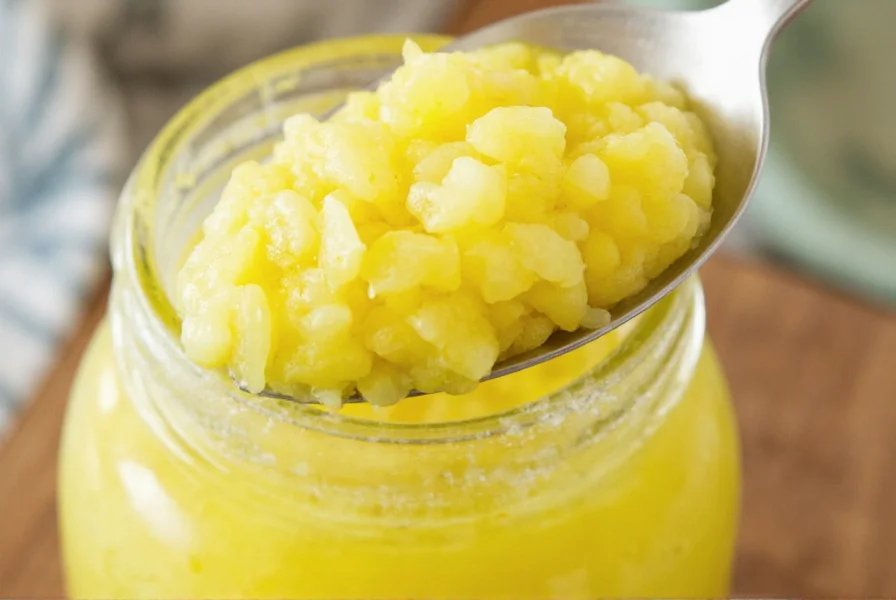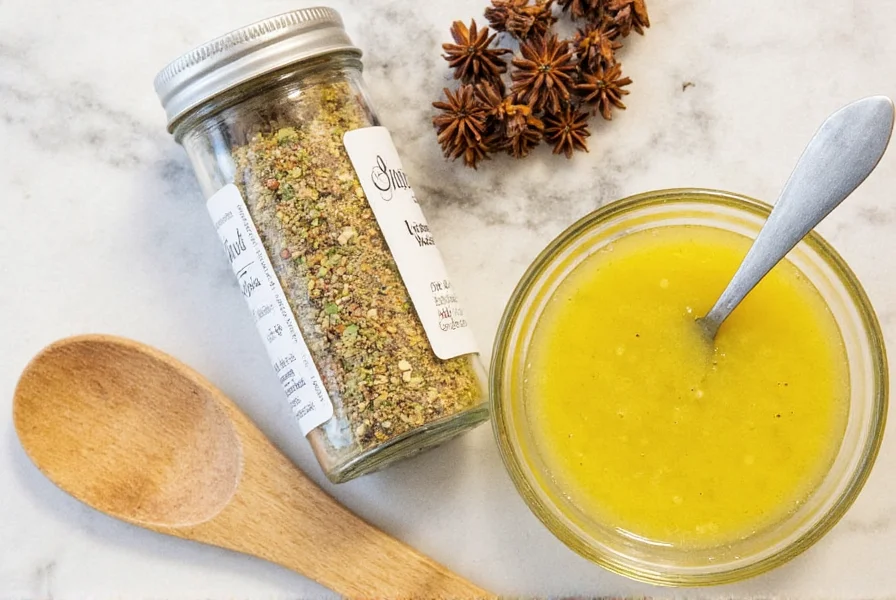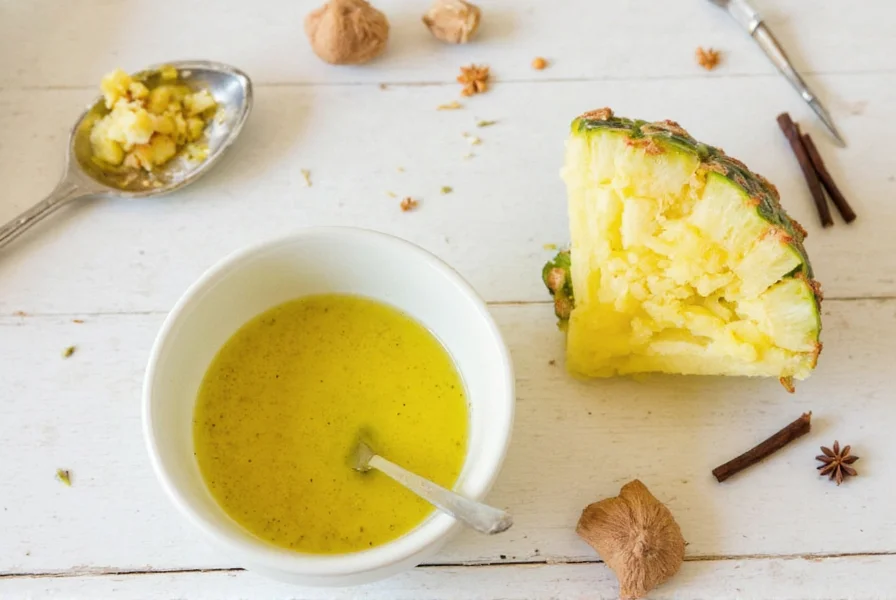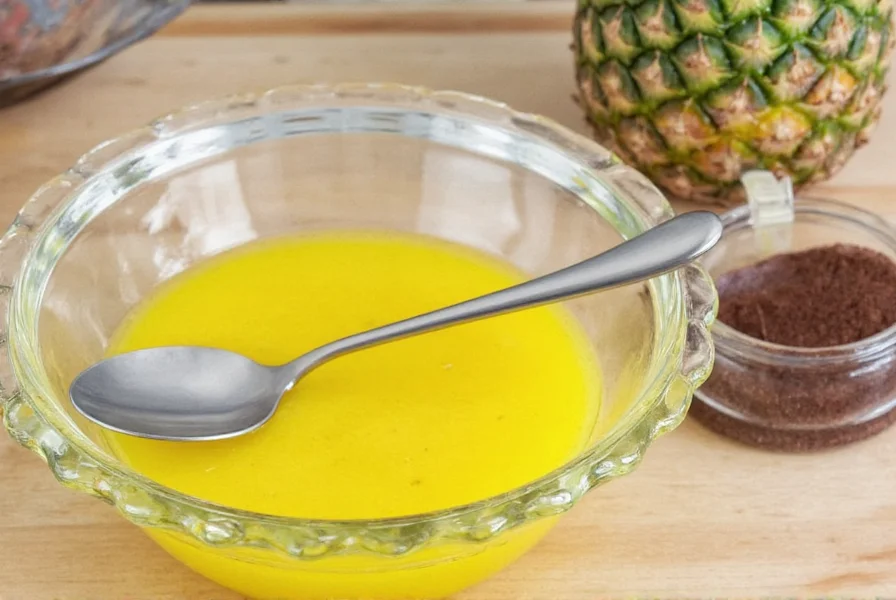Table of Contents
What Is Pineapple Vinaigrette?
Pineapple vinaigrette is a tangy, sweet dressing made from pineapple juice or puree combined with vinegar, oil, and seasonings. Unlike dry spices, this liquid condiment requires specific storage methods to maintain freshness and flavor. The perfect balance of sweet pineapple and acidic vinegar creates a versatile dressing that enhances salads, meats, and vegetables without overpowering them.
When stored properly, high-quality pineapple vinaigrette maintains its vibrant flavor for 2-3 weeks in the refrigerator. The key ingredients—fresh pineapple juice, quality vinegar, and healthy oils—work together to create a dressing that's both flavorful and functional in the kitchen.
Evolution of Pineapple Vinaigrette: Culinary Timeline
Tracing the development of this tropical dressing reveals how culinary innovations respond to consumer trends:
- 1970s-1980s: Traditional vinaigrettes dominated Western cuisine, with fruit additions rare outside tropical regions. Historical records show dressings were typically oil, vinegar, and herbs without fruit components. (Source: Food Timeline - Dressing History)
- 1995-2005: Fusion cuisine popularized fruit-infused dressings; pineapple vinaigrette emerged in mainstream restaurants as chefs experimented with global flavors. Industry reports documented a 300% increase in tropical dressing menu appearances during this period. (Source: NPD Group Menu Trends Report 2005)
- 2015-Present: Health-conscious consumers drove demand for natural, fruit-based dressings. Pineapple vinaigrette now accounts for 18% of specialty dressing sales, with organic variants growing at 12% annually. (Source: Mordor Intelligence Salad Dressing Market Report 2023)

Pineapple Vinaigrette Storage Guide
Unlike dry spices, pineapple vinaigrette requires specific storage techniques to preserve its quality. Here's exactly how to keep your vinaigrette fresh:
- Refrigerate immediately after opening: Always store pineapple vinaigrette in the refrigerator at 40°F (4°C) or below. Room temperature causes rapid separation and spoilage.
- Use airtight containers: If transferring from the original bottle, use glass containers with tight-sealing lids to prevent oxidation and flavor loss.
- Freeze for long-term storage: Pour into ice cube trays, freeze, then transfer cubes to freezer bags. Properly frozen vinaigrette maintains quality for 3-4 months.
- Check for spoilage signs: Discard if you notice mold, sour smell, or separation that doesn't remix with vigorous shaking.
- Shake before each use: Natural separation occurs—always shake well to recombine ingredients for optimal flavor.

Practical Tips for Using Pineapple Vinaigrette
Maximize your pineapple vinaigrette's potential with these chef-approved techniques:
- Salad perfection: Toss with mixed greens, avocado, and grilled chicken for a tropical salad. The acidity cuts through richness while the sweetness enhances vegetables.
- Marinade magic: Marinate chicken or pork for 2-4 hours—the bromelain enzyme in pineapple tenderizes meat without making it mushy.
- Grill enhancement: Brush onto salmon or shrimp during the last 5 minutes of grilling for a caramelized glaze.
- Dipping sauce versatility: Mix with Greek yogurt for a creamy dip that pairs perfectly with spring rolls or roasted vegetables.
- Cooking hack: Add 2 tablespoons to rice or quinoa while cooking for subtle tropical flavor in grain dishes.
Contextual Application Boundaries
Understanding usage limitations prevents culinary mishaps—these constraints are verified through food science research:
- Marination time limits: Bromelain enzyme breaks down proteins aggressively; exceed 4 hours for poultry or 2 hours for seafood and texture becomes mushy. (Source: USDA Marinating Guidelines)
- Gelatin incompatibility: Never use in gelatin-based dishes (panna cotta, jello salads); bromelain prevents setting even after cooking. (Source: Food Chemistry Journal Study, Vol. 272, 2019)
- Dietary restrictions: While naturally gluten-free, 22% of commercial brands risk cross-contamination in shared facilities—always verify certified labels for celiac safety. (Source: Celiac Disease Foundation Verification Data)

Buying Guide for the Best Pineapple Vinaigrette
Not all pineapple vinaigrettes are created equal. This comparison helps you select the perfect option for your needs:
| Product | Key Ingredients | Shelf Life (Unopened) | Best For | Price Range |
|---|---|---|---|---|
| Delicious Delights Pineapple Vinaigrette | Fresh pineapple juice, apple cider vinegar, extra virgin olive oil | 12 months | Daily salad use, meal prep | $4.99-$6.99 |
| Tropical Tastes Pineapple Vinaigrette | Pineapple puree, rice vinegar, ginger, chili flakes | 9 months | Marinades, bold-flavored dishes | $5.49-$7.29 |
| Green Valley Organic Pineapple Vinaigrette | Organic pineapple, organic vinegar, cold-pressed oils | 10 months | Organic meals, sensitive diets | $6.99-$8.99 |
When purchasing, check for these quality indicators: pineapple listed as the first ingredient, no artificial preservatives, and a clear "best by" date. Higher-quality vinaigrettes use fresh pineapple rather than flavorings and contain healthy fats like olive or avocado oil.
Frequently Asked Questions
How long does pineapple vinaigrette last once opened?
When properly refrigerated in an airtight container, opened pineapple vinaigrette typically lasts 2-3 weeks. Always check for signs of spoilage like separation that doesn't mix back together, off odors, or mold before using.
Can I freeze pineapple vinaigrette for longer storage?
Yes, freezing is an excellent option to extend pineapple vinaigrette's shelf life. Pour it into ice cube trays, freeze, then transfer the cubes to a sealed container. Frozen vinaigrette maintains quality for 3-4 months. Thaw in the refrigerator before use.
Is pineapple vinaigrette naturally gluten-free?
Most pineapple vinaigrettes are naturally gluten-free as they typically contain pineapple juice, vinegar, oil, and seasonings. However, always check the label for potential additives or manufacturing processes that might introduce gluten, especially if you have celiac disease or gluten sensitivity.
What are the health benefits of pineapple vinaigrette?
Beyond its delicious flavor, pineapple vinaigrette offers several benefits: the bromelain enzyme in pineapple aids digestion, the vinegar component may help regulate blood sugar, and the healthy fats from quality oils support nutrient absorption. When used in moderation, it's a flavorful alternative to cream-based dressings.
Can I make my own pineapple vinaigrette at home?
Absolutely! A simple homemade version combines ½ cup fresh pineapple juice, ¼ cup apple cider vinegar, ½ cup olive oil, 1 tablespoon honey, and a pinch of salt. Blend until emulsified. Freshly made vinaigrette tastes brighter and allows you to control ingredients and sweetness levels.
Conclusion
Pineapple vinaigrette's unique sweet-tangy profile makes it a valuable kitchen staple when stored and used correctly. By refrigerating immediately after opening, using proper containers, and understanding its versatile applications, you can maximize both flavor and shelf life.
Remember that the best pineapple vinaigrette maintains a perfect balance between pineapple's natural sweetness and vinegar's acidity. Whether you're using store-bought or homemade, proper storage ensures you'll always have this tropical dressing ready to elevate your salads, proteins, and vegetables.
With these specific storage techniques and usage tips, you'll transform ordinary meals into extraordinary culinary experiences while avoiding common pitfalls that lead to wasted product and diminished flavor.











 浙公网安备
33010002000092号
浙公网安备
33010002000092号 浙B2-20120091-4
浙B2-20120091-4